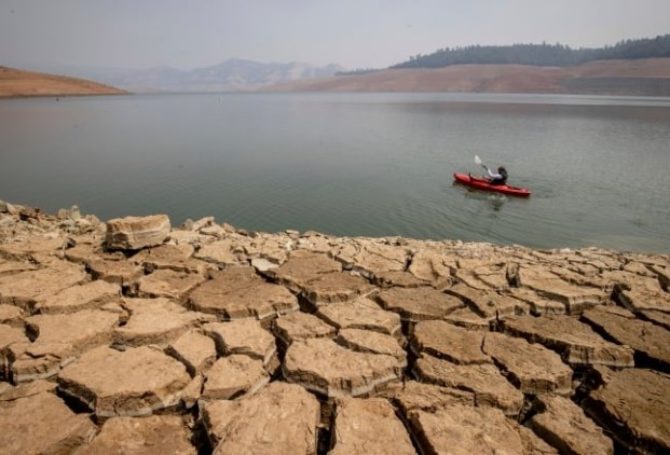
Global climate change has observable effects – glaciers have shrunk, river and lake ice break up earlier, plant and animal ranges have shifted, trees bloom sooner, sea level is rising and heat waves are more intense. And then there is megadrought parching the Western United States.
In a study published this week in Nature Climate Change, climatologists say the West is enduring a drought that began in 2000, making the last two decades here the driest in 1,200 years. The last time the American West was this parched for this long was 800 A.D., based on an analysis of tree ring data. And the current drought isn’t showing any signs of ending.
A cycle of prolonged drought may have occurred no matter what, according to UCLA climate scientist A. Park Williams, the study’s lead author. However, he says, human-caused climate change has made its severity much worse, resulting in sharply reduced water supplies, unprecedented heat waves and raging wildfires that have imperiled farms and ranches, caused death by heat stroke and turned entire cities into ashes.
“Climate change is changing the baseline conditions toward a drier, gradually drier state in the West and that means the worst-case scenario keeps getting worse,” Williams says. “This is right in line with what people were thinking in the 1900s as a worst-case scenario. Today, I think we need to prepare for future conditions that are far worse.”
Wine grapes are the canary in the coal mine of climate change.
No one can predict when the Western drought will end. A relatively wet 2005 failed to break the drought. Desert monsoon rains in the Southwest last summer offered hope the drought may be waning. However, January and February have posted record dry conditions in the West, suggesting drought is hanging around.
That pattern has held true in the Pacific Northwest. Cascade ski resorts didn’t open on Thanksgiving because of a lack of snow. Then came blizzards, followed by record-setting warm conditions when temperatures in Western Oregon topped 60 degrees in February. Mountain snowpack levels have dropped from above average to below average.
It is too soon to predict complete climate Armageddon. However, the picture is especially discouraging for the Southwest. Samantha Stevenson, a climate modeler for the University of California at Santa Barbara, warns the Southwest is parched because land surfaces have warmed up considerably. “We’re sort of shifting into basically unprecedented times relative to anything we’ve seen in the last several hundred years,” she says.
Around 11,000 years ago, a millennium later than the previous record megadrought in the American West, the Sahara wasn’t a desert. Scientists say what is now sand was then covered with plant life, supported animal diversity and included a megalake covering 42,000 square miles. That is about the same size as Lake Michigan and Lake Huron combined.
Thanks to the current megadrought, the Great Salt Lake, which covers only 1,699 square miles, has reached its lowest water level in recorded history.
Wine as Canary in the Coal Mine of Climate Change

Dr. Greg Jones, who is a renowned wine climatologist and now CEO of Abacela Winery near Roseburg, says wine grapes are the canary in the coal mine of climate change. Appearing on a segment of 60 Minutes last weekend, Jones played a starring role in describing the undeniable effects of climate change, using wine grapes as the avatar.
A contributing author to the international climate report that earned a Nobel Prize in 2008, Jones says last June was the second warmest growing season on record. Oregon wine grape growers have adapted, at least so far, by harvesting grapes earlier and earlier. In the northern part of the state, growers have planted vines further up hillsides where temperatures are marginally cooler. Throughout the state, vintners are experimenting with warmer-climate varietals. Full-bodied red wines produced in Eastern Oregon and Eastern Washington now rival those in Napa, which is under stress from heat and wildfires.
Jones said a parchment dating back to 1354 has been discovered at the Church of Notre Dame in Burgundy, France. “It’s a wonderful data record that we’ve been able to look at to better understand what climates were like back then, how it affected harvests and what that looks like today.”
The situation is severe enough that vintners in France are experimenting with wine grapes associated with Spain, Greece and Portugal. Perhaps the best canary in the coal example are grape vine cuttings from the famous French Champagne region now flourishing and producing quality sparkling wine in the cooler reaches of England.




